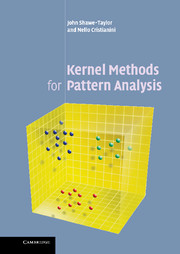Book contents
- Frontmatter
- Contents
- List of code fragments
- Preface
- Part I Basic concepts
- Part II Pattern analysis algorithms
- Part III Constructing kernels
- 9 Basic kernels and kernel types
- 10 Kernels for text
- 11 Kernels for structured data: strings, trees, etc.
- 12 Kernels from generative models
- Appendix A Proofs omitted from the main text
- Appendix B Notational conventions
- Appendix C List of pattern analysis methods
- Appendix D List of kernels
- References
- Index
9 - Basic kernels and kernel types
from Part III - Constructing kernels
Published online by Cambridge University Press: 29 March 2011
- Frontmatter
- Contents
- List of code fragments
- Preface
- Part I Basic concepts
- Part II Pattern analysis algorithms
- Part III Constructing kernels
- 9 Basic kernels and kernel types
- 10 Kernels for text
- 11 Kernels for structured data: strings, trees, etc.
- 12 Kernels from generative models
- Appendix A Proofs omitted from the main text
- Appendix B Notational conventions
- Appendix C List of pattern analysis methods
- Appendix D List of kernels
- References
- Index
Summary
There are two key properties that are required of a kernel function for an application. Firstly, it should capture the measure of similarity appropriate to the particular task and domain, and secondly, its evaluation should require significantly less computation than would be needed in an explicit evaluation of the corresponding feature mapping ϕ. Both of these issues will be addressed in the next four chapters but the current chapter begins the consideration of the efficiency question.
A number of computational methods can be deployed in order to shortcut the computation: some involve using closed-form analytic expressions, others exploit recursive relations, and others are based on sampling. This chapter aims to show several different methods in action, with the aim of illustrating how to design new kernels for specific applications. It will also pave the way for the final three chapters that carry these techniques into the design of advanced kernels.
We will also return to an important theme already broached in Chapter 3, namely that kernel functions are not restricted to vectorial inputs: kernels can be designed for objects and structures as diverse as strings, graphs, text documents, sets and graph-nodes. Given the different evaluation methods and the diversity of the types of data on which kernels can be defined, together with the methods for composing and manipulating kernels outlined in Chapter 3, it should be clear how versatile this approach to data modelling can be, allowing as it does for refined customisations of the embedding map ϕ to the problem at hand.
- Type
- Chapter
- Information
- Kernel Methods for Pattern Analysis , pp. 291 - 326Publisher: Cambridge University PressPrint publication year: 2004
- 5
- Cited by



